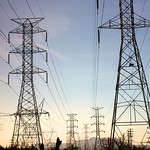By Romany Webb
 At 6:38pm on August 14, the California Independent System Operator (CAISO)—the entity that manages much of California’s electricity grid—ordered electric utilities to initiate temporary rolling service cuts. As a result, nearly half a million customers lost electricity, some for over two hours. The following evening, over 320,000 customers lost electricity for up to ninety minutes, again due to CAISO ordered service cuts. Many were quick to blame the outages on the high level of renewable generation in California (see here and here for examples). The editorial board of the Wall Street Journal went so far as to declare the outages “a warning to the rest of America about the risks of Green New Deal policies.” In fact, however, the outages highlight the risks of failing to adopt policies to mitigate further climate change and plan for climate impacts that are already occurring or locked in.
At 6:38pm on August 14, the California Independent System Operator (CAISO)—the entity that manages much of California’s electricity grid—ordered electric utilities to initiate temporary rolling service cuts. As a result, nearly half a million customers lost electricity, some for over two hours. The following evening, over 320,000 customers lost electricity for up to ninety minutes, again due to CAISO ordered service cuts. Many were quick to blame the outages on the high level of renewable generation in California (see here and here for examples). The editorial board of the Wall Street Journal went so far as to declare the outages “a warning to the rest of America about the risks of Green New Deal policies.” In fact, however, the outages highlight the risks of failing to adopt policies to mitigate further climate change and plan for climate impacts that are already occurring or locked in.
A new report published this week by the California Public Utilities Commission (CPUC), California Energy Commission (CEC), and CAISO identifies “climate change-induced extreme heat” and other weather events as key contributors to the August outages. According to the report, a multi-day heat wave resulted in higher than expected demand for electricity, principally due to above normal use of air conditioners. At the same time, the heat reduced the operating capacity of natural gas generating facilities, leading to a reduction in their output. Hydroelectric generation was also lower than normal because of a prolonged drought, while solar facilities were affected by clouds from a storm. On top of these generation disruptions, a series of wildfires were threatening the loss of major transmission lines, which further restricted electricity supply.
To some, it might seem like bad luck that so many adverse events would occur simultaneously, but it should not be a surprise. Scientists have long warned that multiple climate impacts will occur in parallel and thus have compounding effects on electricity and other systems. California is not the first state to experience this. Back in 2015, parts of Washington state experienced higher than average temperatures which led to a spike in electricity demand at the same time as a wildfire forced the shutdown of a transmission line, necessitating the curtailment of output from a hydroelectric generating facility. In that case, the electricity stayed on, but only because the local utility—Seattle City Light—purchased replacement supplies from other generators at a cost of approximately $100,000 per day. That was not possible in the California case because extreme high temperatures were occurring all across the western U.S., meaning that other states were also experiencing a supply crunch and thus could export less electricity to California.
These types of multi-hazard events are expected to occur more frequently in the future. Maintaining electricity system reliability in the face of such events will require fundamental changes to system planning. As previously discussed on this blog (here, here, and here), electricity system planning typically fails to account for climate impacts, with demand and other forecasts being based on historic data that do not reflect future climate conditions. Consider, for example, California’s resource adequacy planning program. That program aims to ensure that sufficient resources will be available when and where needed to meet electricity demand. In determining the amount of resources needed, the CPUC relies on demand forecasts set by the CEC based on average historic peak demand, reflecting one-in-two year conditions. The CEC adds a fifteen percent “planning reserve margin” to, among other things, “account for plant outages and higher than average peak demand.” Even that was not sufficient to account for the impact of the August heatwaves, however. On August 14, with California experiencing a one-in-thirty-five year heatwave event resulting in temperatures ten to twenty degrees above normal, peak demand was over five percent higher than forecast.
While demand was under-estimated, it appears that supply may have over-estimated, including because the planning process failed to account for the impact of high heat on generating facilities. In determining whether suppliers have met their resource adequacy requirements, the CPUC assigns each resource a qualifying capacity (QC), reflecting the amount of electricity it can provide during peak periods. The QC value for natural gas generators is set equal to their maximum output when operating at full capacity. However, during heat waves, the output of natural gas generators is reduced.
A 2012 study by the Lawrence Berkeley National Laboratory found that most natural gas generators are designed to operate at 59oF and may experience efficiency reductions of up one percent for each 1.8oF increase in temperatures above that level. On August 14 and 15, much of California was experiencing temperatures above 100oF. According to the CPUC / CEC / CAISO report, the high temperatures led to “forced outages and derates,” such that natural gas generators with resource adequacy commitments supplied 1000 megawatts less than required. The report noted that this was to be expected since “[p]lant derates (i.e., a decrease in the resource’s available capacity) due to extreme temperature are not uncommon and in fact increase with temperature.”
These examples clearly highlight the perils of failing to account for climate impacts in electric system planning. The CPUC / CEC / CAISO report called for updates to the resource adequacy program to, among other things, “better account for [h]eat storms and other extreme events resulting from climate change.” That is not sufficient by itself, however. Climate change considerations must be integrated into all electricity system planning processes undertaken by state regulators, the grid operator, and individual utilities and other suppliers.
Recognizing this, in July, the CPUC proposed to require investor-owned utilities to undertake climate vulnerability assessments every four years as part of their rate case filings. Under the proposal, the utilities would be required to identify risks to their assets, operations, and services from changes in “temperature, sea level, . . . precipitation (including snowpack, extreme precipitation events, long-term precipitation trends, drought, subsidence), wildfire, and cascading impacts / compounding incidents” over the next fifty years and options for managing those risks. The CPUC should move forward with the proposal and impose similar requirements on other entities under its jurisdiction. Again, however, that will not be sufficient by itself. The CPUC lacks jurisdiction over key players in the California electricity industry, including the grid operator CAISO, which falls under the authority of the Federal Energy Regulatory Commission (FERC). The Sabin Center has previously argued (here and here) that FERC should take steps to ensure that CAISO and other grid operators adequately assess and plan for the impacts of climate change. Unless and until that happens, we can expect to see more frequent electricity outages, affecting more customers.
Romany Webb is a Research Scholar at Columbia Law School, Adjunct Associate Professor of Climate at Columbia Climate School, and Deputy Director of the Sabin Center for Climate Change Law.





